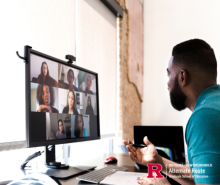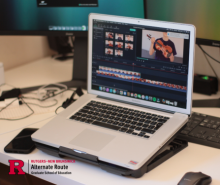New Jersey Education Leaders Share Tips for Teaching in Virtual Learning Environments

Educators now have a year of virtual learning experience under their belts, and looking back on this somber anniversary, it is inspiring to see how these educators have risen to the occasion.
These incredible groups of people had a huge learning curve ahead of them. While there are plenty of educators that are comfortable with existing and emerging tech, many had to learn multiple new programs, and do so fast.
To get an idea of the challenges educators have faced and the lessons they have learned, we turned to a few of our Program Advisory Council members. This group of individuals represents the best in New Jersey education and we are proud they are part of the Rutgers Alternate Route community. Overall, these esteemed professionals have been impressed with their colleagues’ resilience, willingness to adapt and dedication to student success.
Below are three lessons our Program Advisory Council members have learned through virtual learning!
1. Incorporating technology in teaching has improved student engagement
Prior to 2020, educators didn’t lean into all the options technology offers as much as they could. Now that education relies on technology to succeed, students and teachers are seeing its benefits.
“By increasing technology use, we have an opportunity to give kids more freedom and choice, which is exciting for both the teacher and the student,” said Dr. Tamika Pollins, Director of Diversity, Equity and Inclusion at Hoboken Public Schools, “Students are also not looking at what each other’s doing, which has put more focus on their own work and exploring creativity.”
Teachers are exploring their creativity, too.
Dr. Kisha Porcher, Assistant English Professor at University of Delaware and former Rutgers Grad School of Education instructor, has found inspiration in an unlikely tool: TikTok. Dr. Porcher enjoys the brief, one-minute video format and has been using the app to deliver lessons to her students. Naturally, the students loved it.
Jamboard and Padlet are two other resources Dr. Porcher recommends for virtual teaching.
“My students think I'm the corniest ever, but they know when I pull up a Jamboard it’s time to JAM.”
Between the two tools, Dr. Porcher’s students have options to explore different modalities to showcase their work. Students can turn in their work via voice memos, videos, Snaps, documents and more.
“The pandemic has been difficult for students to handle,” Dr. Porcher said. “Instead of a five-page paper, they can jump on Padlet and give me a five-minute video. There are many different ways to measure achievement.”
For teachers going on screen day to day, Ayanna Taylor says a Ring light is essential.
“It ensures you have good lighting if you are teaching classes at night,” said Taylor, who is Clinical Assistant Professor, English Education and Director of Undergraduate Studies at Steinhardt School of Culture, Education and Human Development. Taylor also serves on the Board for Warren Township.
She also shared a video-conferencing tip all educators should know.
“It’s important to remember to select ‘Use computer sound’ when you are sharing your screen and using video. Otherwise, the students aren’t always able to hear it.”
2. Celebrate what's working
The past year has been incredibly stressful for students and educators. And while a lot has gone wrong, there are plenty of things that have gone right.
For Dr. Porcher, who teaches education students, this means checking in with students every class session and reminding them how necessary it is to offer grace during this time.
“I keep trying to remind my students that the grace they expect from me as a teacher should be extended to their students. This is humanizing our experience.”
In one class discussion, Dr. Porcher asked everyone what they are grateful for.
“We have a moment to talk about what’s happening - getting vaccinated, coping with how teaching turned out to be,” she said. “A lot of people have lost family and been sick themselves. Instead, I want them to tell me their wins in being able to deliver content, building relationships, anything in their lives they are proud of.”
The positive and encouraging example has been infectious on her students, who organically began celebrating each other’s accomplishments.
“In education, we focus so much on perfection that we don't focus on what we're doing well,” Dr. Porcher said. “I’m not expecting all my students to be perfect, so what can we celebrate?”
3. The future likely includes hybrid learning
When asked about what hybrid learning’s future looks like, our council members all have diverse insight.
Taylor thinks new ways to connect with students and staff will continue to benefit the learning environment.
“One challenge community is intrinsic to successful learning, and the COVID-19 pandemic has challenged educators to seek new ways to connect,” she said.
But, she notes, in order to be successful, there has to be a mindful effort to cultivate community through these new communication options.
“What’s always challenging is to intentionally build the community and connection that is easier to develop when you have proximity to other people,” she said. “Instructors have to remember to devote time in each class to building community.”
Dr. Pollins, seeing things continually changing at a rapid pace, says there is still too much uncertainty and it is too soon to speculate.
“The CDC is working out a new set of guidelines, so to speak without knowing the guidelines would be premature,” she said.
If hybrid is here to stay, Dr. Pollins says it’s important to consider parents and guardians.
“There’s a lot that affects family,” she said. “Parents are working in a situation where they think this could go on forever and I’m not sure if all parents will want remote learning.”
However, if schools offered parents and students more options and flexibility, it could be transformative for education.
“I think students will expect more creative use of technology from now on,” Taylor said. “I think universities will try to limit fully remote options because most undergraduates want an on-campus experience and universities want to stay competitive. I do think professors will consider hybrid learning as a norm now that we’ve proven that remote instruction can be quality.”
At the University of Delaware, Dr. Porcher is already seeing high demand for permanent hybrid-learning options.
“Students like to work at home sometimes and they also like to be on campus. We’ve opened up a great box because there are things we said would never work and we’ve shown people we can get this work done and have it be effective.”
If you’re considering following your dream of teaching, Rutgers Alternate Route can offer you the support and training you need to succeed. Be sure to follow Rutgers Alternate Route on Twitter and sign up for Alternate Route’s monthly newsletter for more information and stories from the field of education.

 Heather Ngoma has over 25 years of experience collaborating with educators across New Jersey to drive education innovation. She currently serves as the Director of the Rutgers-GSE Alternate Route Program in the Department of Learning and Teaching, a program which helps career changers, recent college graduates, and other aspiring education professionals become licensed teachers in New Jersey. Follow her on Twitter @heatherngoma.
Heather Ngoma has over 25 years of experience collaborating with educators across New Jersey to drive education innovation. She currently serves as the Director of the Rutgers-GSE Alternate Route Program in the Department of Learning and Teaching, a program which helps career changers, recent college graduates, and other aspiring education professionals become licensed teachers in New Jersey. Follow her on Twitter @heatherngoma.





